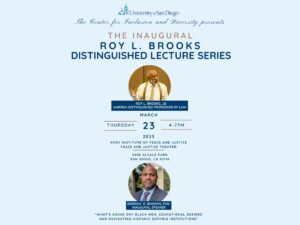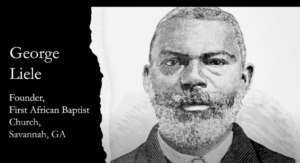The Effects of Racism on Black Men’s Education
For my event I chose to attend a lecture sponsored by The Inaugural Roy L. Brooks Distinguished Lecture Series. The Lecture was given by Dr. Derrick R. Brooms and was titled “What’s going on? Black men, educational desires, and navigating Hispanic serving institutions . The beginning of the event was reserved for Highlighting the accomplishments of Roy L. Brooks.. The host talked about Roy L. Brooks impressive academic history and also about the contributions he made towards racial equality. After this introduction, Derrick R. Brooms began his lecture on the effects of racism in the educational system and how it is skewed against Black men. At the beginning Dr. Brooms talked about his own personal experience of prejudice living in Chicago, one of the most racially segregated cities in America, and how that affected his personal confidence towards his ability to succeed in academia. He also discussed his personal struggles at college where he felt alone and misunderstood. He then went on to mention the main focus of his research and his unique methods. Dr. Brooms mentioned the need for researchers to treat their subjects like real individuals and build relationships with them and focus on the positive ways to affect the participants instead of fixating on reading their negative reality. Dr. Brooms mentioned how African American boys and men are facing an uphill battle when it comes to successes in academia. One of the main reasons why African-Americans struggle so much in academia is because of the other pressures affecting their lives. These pressures are numerous and include the following: poverty, negative portrayals in the media, the presence of crime, especially gang crime, the pressure from the community to stay in the neighborhood and stay connected, and of course the struggle of surviving in a racially prejudiced country.
Dr. Brooms’ solution to these problems is to try to create a better community of support to African Americans in academia, specifically African-American boys. He mentioned a need for a campus geography,or overarching system of support. This geography includes,representation ,relationships,campus culture, connections across campus spaces, holistic care, belonging and mattering. He also mentioned the need to stop comparing Black men and individuals to white men and individuals due to the difference in burden that the Black individuals face. To illustrate the need for a more systemic and diverse support system for Black men, he shared the story of an interaction he had with a research participant, a Black college student who talked about his GPA, which was roughly a C. The student said that simply surviving was good enough for him considering all the forces working against his successes. He ended his lecture with hope that through African American peer support that Black men could find greater success in academia.
Dr. Brooms’ lecture was a reminder that whenever the general population is experiencing hardships, the African- American community suffers even more. The book Freedom on my Mind mentions that during the Great Depression while everyone was negatively affected, African Americans were affected far worse than they’re white peers. In major northern cities the average unemployment rate for African Americans was around 50% compared to 31% for white Americans in those same cities(5)(7). Even after actions were taken by Roosevelt and his administration to lessen the burden of the depression on Americans through the The New Deal programs, African Americans did not receive the same relief as white Americans did. As Freedom on my Mind states, “The New Deal did not help all Americans equally, however. The racial discrimination that permeated America permeated New Deal programs as well. Some called the New Deal a “raw deal” for African Americans.”(pg 721). The New Deal failed to supply African Americans with much needed aid. For instance when programs were administered locally, especially in the South, there was a discrepancy between benefits that whites and Blacks received with Blacks receiving less(5).
An issue facing developing countries right now is a large disparity between the academic success of boys and girls. There is a 10% difference between the amount of women who have bachelor’s degrees and the amount of men who have bachelor’s degrees. Like most issues this academic gap is even larger among Black men and Black women(6). The Journal of Blacks in Higher Education notes “At 24 of the 26 universities in our survey, the gender gap among Black students is greater than the gender gap that exists among white students.” (1). There are many different theories behind the reason for the gap in education between men and women. One theory cites the differences between brain development between boys and girls(3). Whatever the reason it is apparent that the problem is worse among African Americans. The reason behind these heightened gender gap among African AMericans is due to racial bias associated with Black men as pointed out by Dr. Brooms.
Black men have been depicted routinely throughout history as savage animals who have little control over their immense physical power(4). This depiction which was created by a white racial majority served an economic purpose(4). By depicting African-Americans as uncontrolled beasts, slave holders were able to justify their enslavement and subjugation of Blacks(4). This depiction, however, did not end after the emancipation of slaves(4). Today African Americans are commonly depicted as criminals(4). For example, Dr Brooms brought up the Trayvon Martin case where a Black teenager was stopped by a security guard named George Zimmerman(8). Trayvon Martin lived in the community that George Zimmerman was guarding and George Zimmerman attempted to detain Trayvon Martin which he had no legal right to do(8). After Trayvon Martin resisted detainment, George Zimmerman shot and killed him. Dr. Brooms brought up the common media depiction of the two individuals. Showing an example of George Zimmerman’s simple mugshot with no defining features, compared to a photo of Trayvon Martin with two middle fingers and a shirt off which clearly tries to depict him as a criminal force compared to George Zimmerman. It is no wonder then that so many Black men feel as if the world is against them and have difficulty feeling confident in their academic ability as Dr Broom’s points out. Thesenegative and biased depictions of Black men help explain why the academic gender gap is wider in the black community. As with the Great Depression while there might be a larger societal woe that is affecting everyone including Black individuals,the racial bias means that Blacks experience this effect worse.
A solution to issues facing Black men in academia brought up by Dr. Brooms is to give greater support to African American men by giving them peers who they can talk to. The practice of relying on each other’s Black peers was common during the Great Depression. As noted in Freedom on My Mind “African Americans relied on their core values — their deep commitment to family, kin, friends, neighbors, communities, and religion — to survive the Great Depression.”(725). The book mentions that in many Black communities individuals share clothing and provide food for their more needy brethren(5). Independent Black churches also provided spiritual guidance and essentials such as food during this time of financial and mental stress(5). Dr. Brooms points out that at this time Black men need mental support and encouragement from their black peers and from the academic institutions they’re attending. As mentioned before, he proposes creating a geography of support on college campuses which will help provide much needed emotional and mental support to Black male students who are struggling to succeed in academia.
In conclusion, it is evident that while the struggle between men and women in terms of their ability to succeed in academia is a prominent social issue that is affecting all ethnicities, it appears to be affecting the African-American community in a disproportionate way. This is not unique to African-American history as many prominent social and economic issues that affected all ethnicities always seem to affect the African American community worse. During these times and to cope with the disparity they face, the Black community has sought refuge in each other in order to survive. Dr. Brooms has hope that Black men can gain greater confidence in their ability to succeed and overcome the overwhelming adversity facing them by relying on the support of fellow Black peers and building a community of support.
Work Cited
“Black Women Students Far Outnumber Black Men at the Nation’s Highest-Ranked Universities.” Black women students far outnumber black men at the nation’s highest-ranked universities, 2006. https://www.jbhe.com/news_views/51_gendergap_universities.html.
Jr., Marshall Anthony, Andrew Howard Nichols, and Wil Del Pilar. “Raising Undergraduate Degree Attainment among Black Women and Men Takes on New Urgency amid the Pandemic.” The Education Trust, December 21, 2021. https://edtrust.org/resource/national-and-state-degree-attainment-for-black-women-and-men/#:~:text=Slightly%20more%20than%20half%20of,gap%20of%2018%20percentage%20points.
Male inequality, explained by an expert. YouTube. YouTube, 2023. https://www.youtube.com/watch?v=DBG1Wgg32Ok.
Allen, Quaylan, and Henry Santos Metcalf. “‘Up to No Good’: The Intersection of Race, Gender, and Fear of Black Men in US Society.” In Historicizing Fear: Ignorance, Vilification, and Othering, edited by Travis D. Boyce and Winsome M. Chunnu, 19–34. University Press of Colorado, 2019. http://www.jstor.org/stable/j.ctvwh8d12.4.
White, Deborah G., Mia Bay, and Waldo E. Martin. Freedom on my mind: A history of African Americans, with documents. BibliU. Boston: Bedford/St. Martins, 2021.
Parker, Kim. “What’s behind the Growing Gap between Men and Women in College Completion?” Pew Research Center, November 8, 2021. https://www.pewresearch.org/short-reads/2021/11/08/whats-behind-the-growing-gap-between-men-and-women-in-college-completion/.
“Unit 11 1930s: The Great Depression.” New Jersey State Library, March 29, 2021. https://www.njstatelib.org/research_library/new_jersey_resources/highlights/african_american_history_curriculum/unit_11_great_depression/#:~:text=Throughout%20this%20economic%20crisis%20unemployment,and%2052%20percent%20for%20blacks.
“Trayvon Martin Shooting Fast Facts.” CNN, February 15, 2023. https://www.cnn.com/2013/06/05/us/trayvon-martin-shooting-fast-facts/index.html






